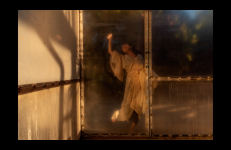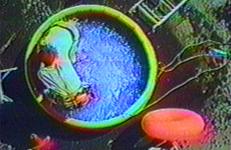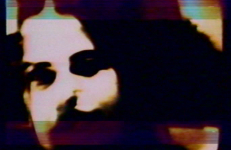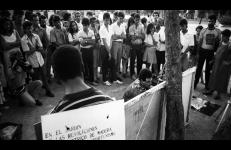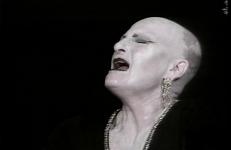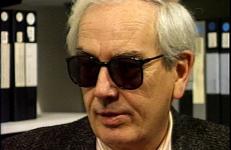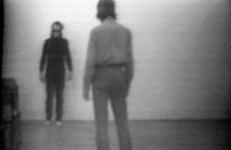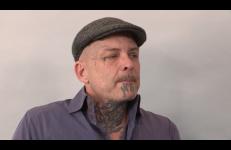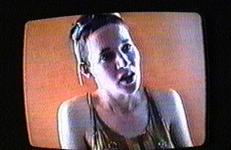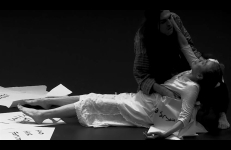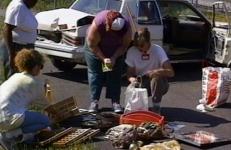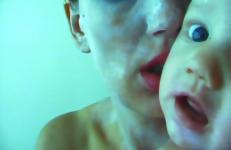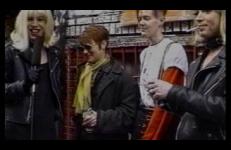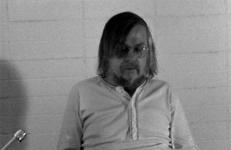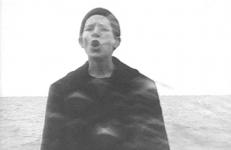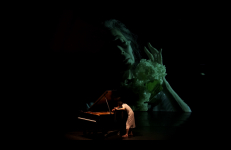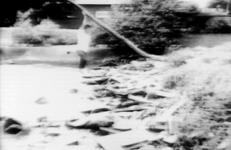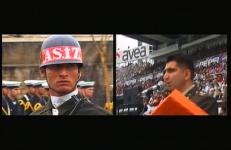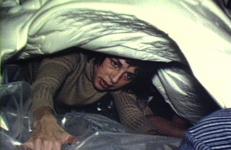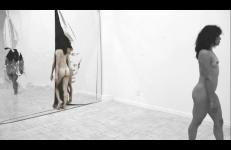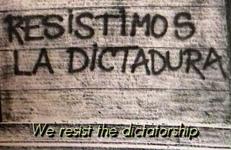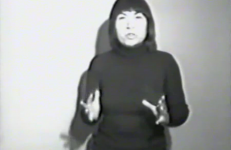Through the testimonies of five women, this video lays out the complex problem of anorexia, detailing how the disease develops as a response to both personal and societal pressures. The common thread in these accounts is how the disease clusters around a need to control one’s body, and how not-eating becomes a way to gain that control, with anxieties and frustrations being displaced onto a negative obsession with food.
Performance
This is the fourth work of Eiko's 2020 Wesleyan Virtual Creative Residency and a collaboration with William Johnston. After seeing Room and Visit, Bill (another collaborator of Eiko at the 2017 Rauschenberg Residency) sent her photographs taken in the same space.
Photographs by William Johnston
Video and sound edit by Eiko Otake
Soundscape created in collaboration between Eiko Otake and David Harrington (violin).
Actions speed up, slow down, and run at regular speed. The usual props are there, as is a wet dog. Subtle nuances are revealed as the behavior of the anxiety-laden protagonists is rendered, for once, in real-time.
This title is also available on HalfLifers: Rescue Series and HalfLifers: The Complete History.
Using highly-manipulated and over-processed images, Latham investigates the process of video as inherently fragmented. Weaving together various people’s impressions of the artist and her work, the work demonstrates important parallels between video, storytelling, and the formation of identity — all processes of active fabrication that blend “lies” and truth in the construction of a certain reality, history, or past. Labeling an image of herself talking as “her most recent explanation,” Latham addresses “the construction of her video personality” as an identity outside of herself.
This documentary explores the groundbreaking street performances of Cuban artist JuanSí González during the 1980s. A pioneer of relational aesthetic practice in Cuba, González transformed public spaces in Havana into laboratories for edgy exchanges between artists and the public and created numerous works that threw art's role in a socialist society into question. His experiments provoked surprise from his peers and suspicion from state authorities. Twenty years later, the artist sat down to reflect on the relevance of those performances for the development of Cuban contemporary art.
This tape compiles three profiles of performance artists: A Creative Synthesis: George Coates Performance Works (10:00), The Performance World of Rachel Rosenthal (16:00), and Paul Dresher Ensemble (08:00).
Contemporary American composer and performance artist Robert Ashley (1930-2014) was a pioneer in the development of large-scale, collaborative performance works and new uses of language in operas and recordings. His landmark project, Perfect Lives, was opera produced for television in seven half-hour episodes.
As a document of an early performance, this video details the process of orientating the body and self in space, providing a physical metaphor for the process of adjusting oneself in society.
"Blindfolded, ears plugged: our goal is to sense each other’s movement and bearing, to attempt to assume the same movement and bearing. An off-screen voice, heard only by the audience, gives directions that would help us attain our goal."
—Vito Acconci, "Concentration-Container-Assimilation," Avalanche 6 (Fall 1972)
In this interview, extreme performance artist and 1990s culture warrior Ron Athey (b.1961) discusses the genesis of his provocative performance style and the memories and desires that continue to motivate his practice. Athey describes how his particular approach to performance developed dually from his religious upbringing and exposure to devotional theater, as well as from his later interest in the DIY grandiosity of the Los Angeles punk scene.
A 12-year-old Olympic swimmer and her mother (both played by July) speak to the public about going for the gold.
“As the film progresses through subtle editing-in-reverse, July reveals the world around the televised facade. ... [T]he 23-year-old performer convincingly plays both Dawn Schnavel and her mom, or rather, vanishes into them. What’s noticeable isn’t so much the ease with which July transforms herself into a pre-teen girl and an older woman but the similarities and differences between the daughter and the mother July becomes.”
This project on family violence, spanned two years and several sites across the country, and involved wrecked cars in sculptural installations. The cars were reconfigured by women and children who suffered violence at the hands of loved ones. Linked to each other through common experience, women from a domestic violence shelter in Pittsburgh, a family violence program at Bedford Hills prison, children from shelters in Niagara Falls and Cleveland, teenage girls in Oakland, and politicians on Staten Island all collaborated in making the cars.
In Bad Grrrls, Glennda and Fonda LaBruce attend a Riot Grrrl conference on New York’s Lower East Side. At the conference, they conduct interviews with punk women, performers and artists, including Penny Arcade and Sadie Benning. In doing so, Glennda and Fonda navigate a range of perspectives on feminism, punk, and underground activism. Furthermore, they engage with questions of drag’s relationship with feminism, and how one would reconcile the problems of punk with Riot Grrrl’s desire for women’s liberation.
"One of Baldessari’s most ambitious and risky efforts. Seated and holding a sheaf of papers, he proceeds to sing each of Sol LeWitt’s 35 conceptual statements to a different pop tune, after the model of Ella Fitzgerald Sings Cole Porter. What initially presents itself as humorous gradually becomes a struggle to convey Lewitt’s statements through this arbitrary means."
—Helene Winer, “Scenarios/Documents/Images,” Art in America 61 (March 1973)
The image comes up suddenly and then continues unwavering: a young person (Mirra) dressed in a black watchcap and pea coat stands at the edge of a large body of water and sings a sea shanty, occasionally flinching to emphasize certain lyrics or fend off the steady drizzle of rain. The frame is broken up into simple shapes—sea, sky, hat, face, coat—and the longer Mirra sings, the more rain collects on the lens of the camera—threatening to obliterate the subject into the background of sea and sky.
Actor Richard Marcus speaks directly and intimately to the viewer, relating a tale of personal loss, and then changing the subject to baseball. The video is about amateur vs. professional, personal vs. public space, and loyalty and self-confidence.
This title is also available on Chip Lord Videoworks: Volume 1.
Banshee is a duet between Margaret Leng Tan playing The Banshee (Henry Cowell) and Eiko's Night With Moths (camera by Rebekkah Palov) in a performance of The Duet Project: Distance Is Malleable at New York University's Skirball Center on April 16, 2022.
Camera by Alexis Moh .
Edited by Eiko Otake.
The soundtrack begins with the artist stating the conditions: “An artist may construct a work and/or a work may be fabricated and/or a work need not be built. I elected five possibilities for videotape.” These possibilities are the actions executed in Beached. They are shot in five sequences and consist of throwing, pulling, lifting, dragging, and using leverage.
This video has been remastered, though traces of historical picture loss remain.
"I, Soldier is the first part of a video series in which I am dealing with the state-controlled ceremonies for the national days of the Turkish Republic. The nationalistic attributes attached to these large-scale ceremonies are underlined in a non-descriptive and almost voyeuristic point of view. I, Soldier was shot at the National Day for Youth and Sports; the day that marks the start of the independence war of the Turkish public under the leadership of Mustafa Kemal Atatürk, against the Allied Forces back in 1919.
Feminist artist Lynda Benglis is known for her sculptures, video performances, paintings, and photography. Her work in the 1970s was controversial, delving into issues of gender roles within and outside the art world. Produced in conjunction with her retrospective at the High Museum of Art in Atlanta, Dual Natures provides an introduction to Benglis’s work and includes excerpts from her videos of the mid-’70s and footage of the artist at work.
Created from 2014 footage shot at Ethan Cohen Fine Arts Gallery with a mirrored curtain, the performer here meets a ghost of herself.
Performer: Elisa Osborne
Camera: Liliana Gao
Editor: Adam Burke
Special Thanks to Ethan Cohen
Martin Sorrondeguy, former vocalist for Los Crudos, produced this powerful and uplifting documentary about the U.S. Latino punk scene and the DIY movement. The video features live performances by bands, including Huasinpungo, Los Crudos, Subsistencia, Sbitch, and many more.
“I may have to get a back up career.” I mull over what I might do if I don’t make it as an artist. What if I lose my eyes? I figure a career as a stand-up comic is a safe bet and try out a few jokes on an imagined audience — of course with my eyes shut tight.
Performance engineers Survival Research Laboratories (SRL) construct machines that live in their own fictional world, acting out scenarios of perpetual torment, exasperated consumption, and tragic recognition. This film presents a fractured narrative featuring these large anthropomorphic robots and represents Jonathan Reiss and SRL’s collaborative desire to go beyond the restraints of event documentation.





